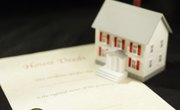As a home buyer, you can ensure that a property is ready for move-in by walking through it one last time before closing. The final walk-through usually takes place within a few days of closing, giving the seller sufficient time to prepare the home and you enough time to remedy issues before the close of escrow. There are several measures you can take when performing a final walk-though to verify the property's condition.
The Basics
Typically scheduled within five to seven days prior to the close of escrow, you do your final walk-through. Your real estate agent can attend and show you what if anything has been to the property to prepare it for sale -- he can show you repairs that have been done, for example. By taking a final walk-through, you're protected from unexpected changes to the property's condition which might render it less desirable. If there's a big hole in a wall that was not there when you bought the home, you can make repairing it a condition of closing the deal. In some cases, as when buying foreclosed property as-is, buyers often bypass the final inspection.
General Checklist
If you like, you can bring along a final walk-through checklist, which you can find online at home-buyer websites or get directly from real estate agents. The checklist includes general items to inspect for, including the removal of seller's contents, whether repairs have been done and whether any fixtures and appliances included in the purchase are still there. Alternatively, you can make your own checklist based on the items you and the seller negotiated in the sales contract. As a rule of thumb, the seller must leave the home in the same or better shape than it was in when you entered into the contract: a relatively clean home, free of trash, debris and the seller's personal items.
Specific Items
Start from the outside of the home and work your way inward when inspecting, recommends the Real Estate Buyer's Agent Council. Examine the home's roof, walls, landscaping, driveway and outdoor structures for changes. Look for new signs of water damage and stains on walls, ceiling and floors. Switch light fixtures on and off and test outlets using a voltage tester, recommends The Family Handyman. Check plumbing by turning faucets on and off, examine the water pressure and look underneath the sink. Flush toilets and run the water to check for clogged drains. Also, test all doors and windows for proper opening and locking; test the heating, ventilation and air conditioning system and all appliances to ensure they function properly.
Remedies
In the event the home isn't up to par at your final walk-through, you may take a few steps to remedy problems. Make note and take photos of the defect. Communicate the issues to the seller, either by letter or by means of a standard form, which your real estate agent can provide. Real estate agents can communicate the issues to the seller to have them resolved. In the event a seller is unable to repair the issue before the close of escrow, you can also negotiate a monetary amount to compensate you for your extra expenses -- for example, to compensate you for a hotel stay while the problems are fixed. Any such agreement must be done in writing.
References
- Real Estate Buyer's Agent Council: Final Walk-Through Checklist
- Inman News: Buyers, Don't Forgo "Final Walk Through"
- Money Instructor: Homebuyers: Take Your Final Walk-Through
- The Family Handyman: Troubleshooting Dead Outlets
- HG.org. "Walk Through Rights During a Home Purchase." Accessed Jan. 29, 2020.
- ARAG North America, Inc."What to Do When You Spot a Problem at Your Final Walk-Through." Accessed Jan. 29, 2020.
- City of Livermore, California. "Termite and Shower Repair Inspections," Page 2. Accessed Jan. 29, 2020.
Writer Bio
Karina C. Hernandez is a real estate agent in San Diego. She has covered housing and personal finance topics for multiple internet channels over the past 10 years. Karina has a B.A. in English from UCLA and has written for eHow, sfGate, the nest, Quicken, TurboTax, RE/Max, Zacks and Opposing Views.

